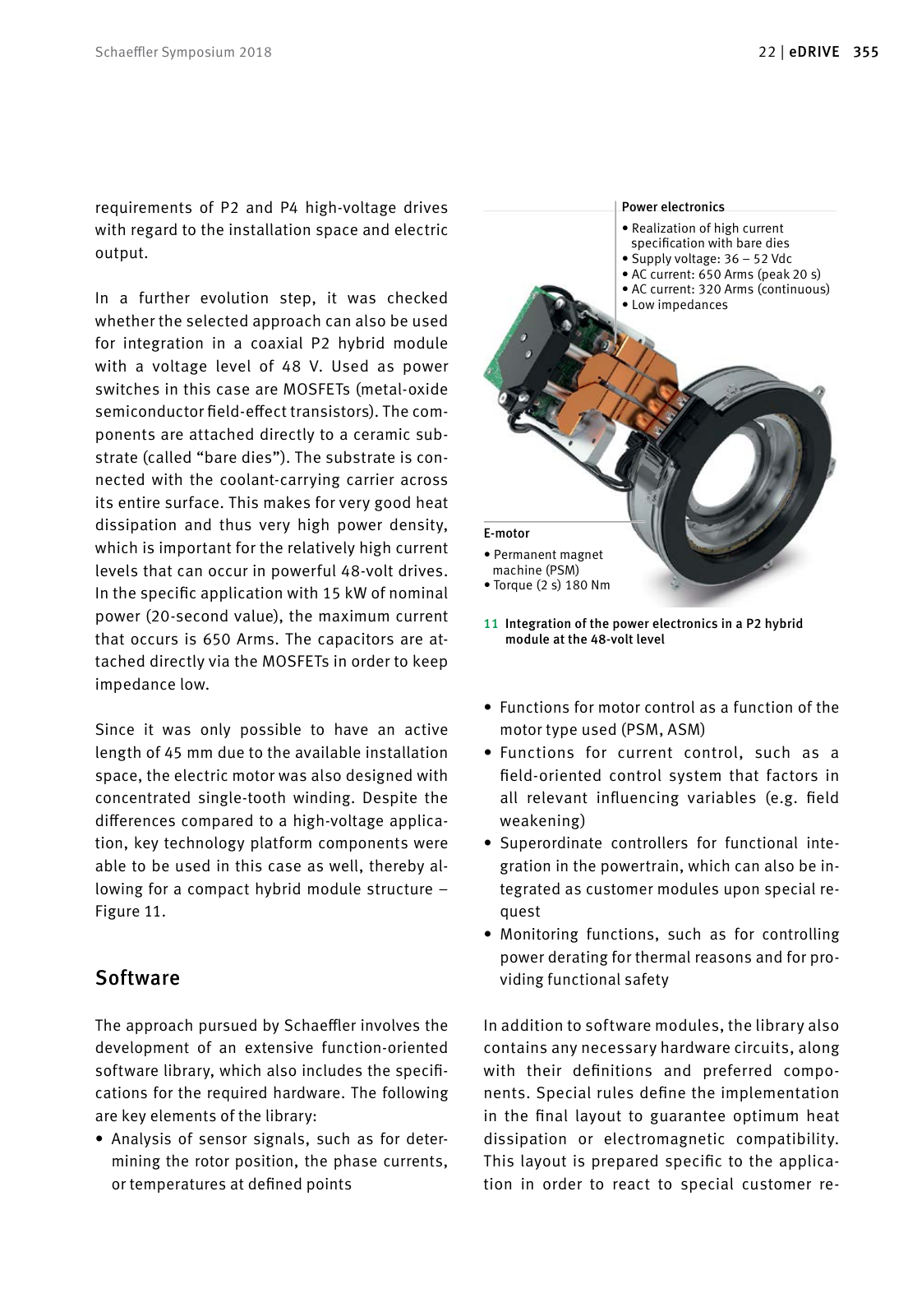354 eDRI V E 22 35522 eD RI V ESchaeffler Symposium 2018 The consistent use of sinter technology increases the cycle stability of the IGBT modules by a factor of 10 in comparison with conventional aluminum bond wire technology Other basic components involved in carrying current are the capacitor and the bus bars which also lead to a loss of power due to the flow of current The flexibility of the installation space is con trolled by the central carrier frame Figure 8 Carrier and cooling frame This injection molded part controls the flow of coolant connects the current carrying components to the heat sink and arranges the basic compo nents with respect to each other CFD simulation is used to optimize this component in order to ensure symmetrical warming of the half bridges Moreover the electrical connections are opti mized with regard to parasitic inductances and capacities In the specific example a power den sity of more than 30 kW l was able to be repre sented Thanks to the flexibility of the installation space and the modular approach it is easy to react to deviating requirements Figure 10 shows an example of a design for use in an electric axle with a maximum output of 150 kW An EMC filter can be integrated on the DC side as an option and can be designed big enough to enable shielding for the DC supply line to be done without This represents a good option for optimizing the system costs at the vehicle level It was able to be demonstrated that the basic concept selected for the power electronics has the necessary flexibility for meeting the different requirements of P2 and P4 high voltage drives with regard to the installation space and electric output In a further evolution step it was checked whether the selected approach can also be used for integration in a coaxial P2 hybrid module with a voltage level of 48 V Used as power switches in this case are MOSFETs metal oxide semiconductor field effect transistors The com ponents are attached directly to a ceramic sub strate called bare dies The substrate is con nected with the coolant carrying carrier across its entire surface This makes for very good heat dissipation and thus very high power density which is important for the relatively high current levels that can occur in powerful 48 volt drives In the specific application with 15 kW of nominal power 20 second value the maximum current that occurs is 650 Arms The capacitors are at tached directly via the MOSFETs in order to keep impedance low Since it was only possible to have an active length of 45 mm due to the available installation space the electric motor was also designed with concentrated single tooth winding Despite the differences compared to a high voltage applica tion key technology platform components were able to be used in this case as well thereby al lowing for a compact hybrid module structure Figure 11 Software The approach pursued by Schaeffler involves the development of an extensive function oriented software library which also includes the specifi cations for the required hardware The following are key elements of the library Analysis of sensor signals such as for deter mining the rotor position the phase currents or temperatures at defined points Functions for motor control as a function of the motor type used PSM ASM Functions for current control such as a field oriented control system that factors in all relevant influencing variables e g field weakening Superordinate controllers for functional inte gration in the powertrain which can also be in tegrated as customer modules upon special re quest Monitoring functions such as for controlling power derating for thermal reasons and for pro viding functional safety In addition to software modules the library also contains any necessary hardware circuits along with their definitions and preferred compo nents Special rules define the implementation in the final layout to guarantee optimum heat dissipation or electromagnetic compatibility This layout is prepared specific to the applica tion in order to react to special customer re 10 Power electronics setup for an electric axle drive Power board Control board Cooling box Half bridge modules Schaeffler development based on electronic platform Optimized cooling design High power density High durability Power scalability Chip independence Multifunctional unit Bus bars and sensors included Integrated signal connectors Carrier for electronic modules Design for most efficient cooling 11 Integration of the power electronics in a P2 hybrid module at the 48 volt level Power electronics Realization of high current specification with bare dies Supply voltage 36 52 Vdc AC current 650 Arms peak 20 s AC current 320 Arms continuous Low impedances E motor Permanent magnet machine PSM Torque 2 s 180 Nm

Hinweis: Dies ist eine maschinenlesbare No-Flash Ansicht.
Klicken Sie hier um zur Online-Version zu gelangen.
Klicken Sie hier um zur Online-Version zu gelangen.